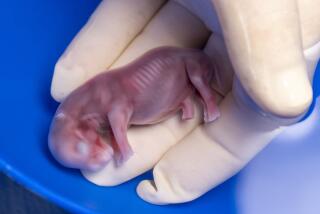Rhino horse, a ‘missing link,’ could solve 55-million-year-old mystery
- Share via
A portly hoofed animal about the size of a wild pig just might help solve a 55-million-year-old mystery of evolution and continental drift.
The mammal, which likely weighed 45 to 75 pounds, probably occupied a branch of the evolutionary tree right beside a broad group that has since radiated out into the modern rhinoceros, horse and hippopotamus, according to a study published online Thursday in the journal Nature Communications.
Cambaytherium thewissi, first described nine years ago, comes as close to being described as a “missing link” as any paleontologist might dare (most eschew the term). It retains features later lost among its sister mammals, the perissodactyls – which includes tapirs, rhinos and horses.
“It’s a transitional form; it’s a missing link, if you like,” said the study’s lead author, Kenneth Rose, a paleontologist at the Johns Hopkins University School of Medicine. “I don’t like that term, because all fossils really are missing links. Anything new is a missing link in your understanding.”
The ancestral rhino horse, pieced together from some 200 bone samples, likely evolved in India well after that land mass broke off from Madagascar about 80 million to 90 million years ago and drifted toward Asia, where it docked tens of millions of years later, according to the study.
“We think what we have is a remnant of the ancestral group that would’ve given rise to horses and tapirs and rhinos,” Rose said. “And it’s on India, and therefore the possibility that perissodactyls actually diversified -- evolved -- on India has gone way up.”
If so, then the ancestor of both may have come from an Afro-Arabian land mass, possibly via an island arc or land bridge, Rose said. Such a connection, however, is a highly contentious hypothesis among geologists, who remain uncertain about both the trajectory of the Indian land mass and the time of its collision with modern Asia, which drove up the Himalayan plateau, he said.
The first fossil specimens of Cambaytherium were unearthed over a 10-year period from a massive open-pit coal mine in Gujarat, India, that now is closed and is being filled. So, paleontologists are fanning out to other mines in search of more ancient layers that might hold fossils that could fill in the mystery of the origin of Cambaytherium.
Such a find would help shed light on what came before a critical explosion of mammalian life about 55 million years ago, when Earth was warming. The Paleocene-Eocene thermal maximum, as it is now known, ushered in a diversity of four-legged grazing animals, along with the primates, with their five-digit hands and feet featuring thumbs and big toes with nails.
Based on analysis of shapes and surfaces of the long bones of its limbs, Cambaytherium probably also had five finger- or toe-like bones, though Rose hesitated at calling them actual digits. That number was reduced in perissodactyls as they developed modern hooves.
The mixture of primitive features that since were lost in sister taxons helped lead researchers to place Cambaytherium thewissi beside the perissodactyl clade.
“We’re saying the node is just one higher on the tree,” Rose said. “That’s in many ways just a matter of semantics. Someone else could come along and say this is a primitive perissodactyl or this is the basal perissodactyl.”
Dig science? Follow me on Twitter: @LATsciguy







